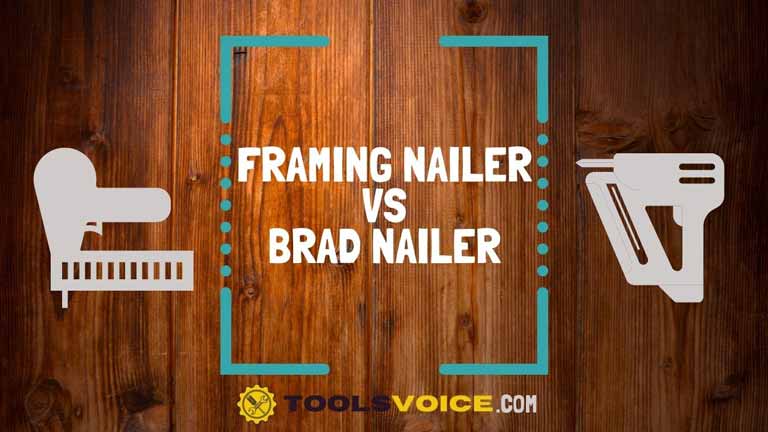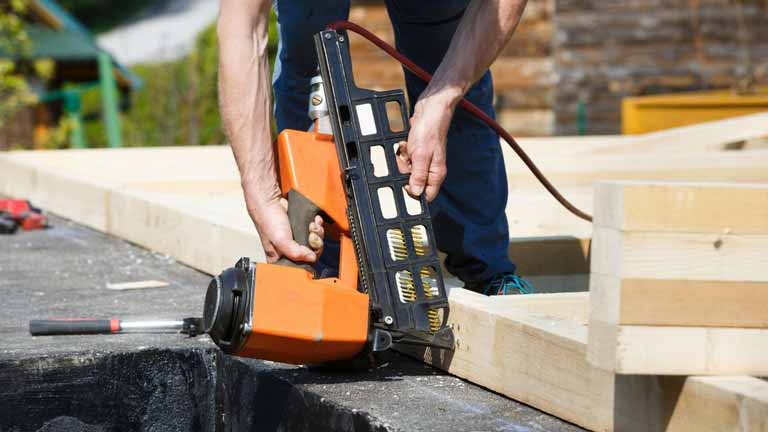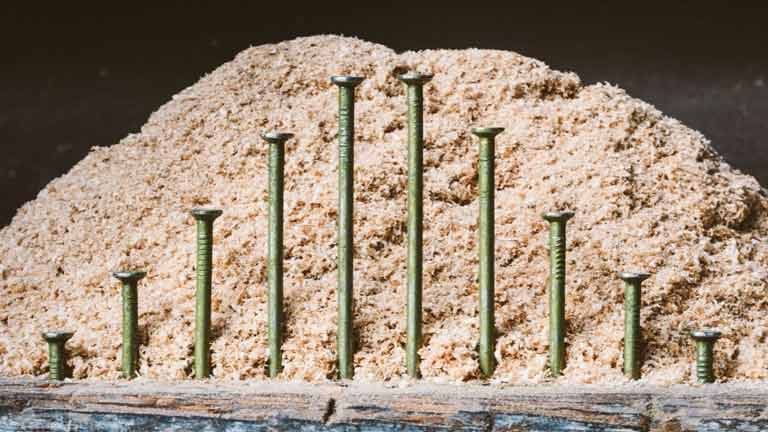Framing nailers and brad nailers are popular power tools for DIY enthusiasts. They are both used to put nails into wood.
However, what’s the difference between a framing nailer and a brad nailer? It might seem like these two tools are very similar, but there are some key differences. A framing nailer is designed for use in the construction industry, while a brad nailer is designed for smaller projects like trimming work.

In this blog post, we will talk about the differences between these two types of tools that will help you choose which one is best for your needs!
Difference Between Framing Nailer and Brad Nailer
Uses
A framing nailer (also called framing stapler) is a type of power nail gun used for nailing surfaces together. They’re mainly used in building construction and home renovation.
The framing nailers are typically used to build studs and sheathing for homes. But, they can also be used on things like outdoor projects, such as deck railings or sheds with wood frames.

Framing nailers are designed to drive nails into harder woods such as oak, hardwoods or hardboard paneling. Plus, they are available in a variety of sizes and models for different purposes.
On the other hand, A brad nailer is mostly used in the carpentry industry where detailed work needs to be carried out on finer items that don’t require all the strength of a framing nailer.
The brad nailers are often used when installing a trim that runs along baseboards. They’re also handy when making boxes and repairing chair seats.

However, they can be found in construction too, especially when finishing an interior project or installing molding around windows and doors where precision is necessary to avoid damaging wallpaper or insulation between studs inside walls.
Nails Size and Their Use
Brad nailer and framing nailer have different uses but the main difference is in their sizes and types of nails used. If you don’t know much about nails, it will be difficult for you to understand the difference between these two tools. So, let’s talk a little bit about nails.
Nail size is measured by its length and gauge size. And nail gauge size is determined by the thickness or diameter of a nail. Low gauge nails mean they are thicker than higher gauge nails. The higher the gauge is, the thinner it is. Plus, the length of nails is measured in inches.
The most popular nail sizes are between 8GA to 18GA (Gauge). This value indicates how many nails can be able to hold in one inch of nail magazine. The 16 gauge nailer nails contain 16 nails per inch. Plus, 16GA 2 and ½ inches nail means a 16 gauge nail with a length of 2 and ½ inches.

Going back to the comparison, framing nailer comes with a wide selection of different gauges so you can find one that suits your style and needs best. They support nail sizes between 8 gauge to 11 gauge. While brad nailer only supports 18 gauge nails.
18 GA nails mean thin nails (also known as brad nails). If you shoot a brad nail into any wood surface it will make an unnoticeable hole that leaves no marks. So, there is no need to use wood putty when using a brad nail gun.
Because of using small diameter nails, brad nailer won’t split wood. That’s why they are used for smaller projects where precision is key.

Generally, brad nailers use 3/8-inch to 2 ½-inch nails in length, and framing nailers use 2 to 3 ½-inch nails in length.
Framing nailers have different types of magazines with several different angles like 21 degrees, 30 degrees, etc. Plus, these nailers only support the size of nails that correspond to their angle.
The magazine’s angle and the type of work determine which angle nail needs to be used. Moreover, framing nail gun only supports two types of nails: clipped head nails and round head nails.
Types
Brad nail guns are available in two basic variations: Cordless brad nailers and Pneumatic brad nailers.
Pneumatic brad nailer needs an air compressor to operate and requires the use of a long hose to transport compressed air from the tool to the nail gun. And cordless nailer uses a lithium-ion battery to generate the nailing power.
Brad nail gun is mostly used by homeowners, typically those who don’t own an air compressor. That’s why consumers prefer to use the cordless version which will reduce the expense of buying an air compressor and increase portability. But pneumatic nailers are faster and provide smooth operation. Check out which one is best for you here!
There are several different types of framing nailers, so it’s important to figure out what you’ll need before you buy one.
There are two major types of framing nail guns available: Pneumatic framing nail guns and Cordless framing nail guns. They both come in either coil, straight and angled magazine setups.
As the name refers, pneumatic framing nailer uses an air compressor to shoot the nails into the wood. When framing crews use a pneumatic nailer to try driving a nail into wood, air from the hose forces a piston into the wood and pushes out the nail.
A battery-powered framing nailer operates much in the same way as a pneumatic framing nailer, but its power comes from a disposable compressed air canister that fits inside of the nail gun.
The interesting part is framing nailer comes with some specific model that only supports either clipped head nail or round head nail. Check out which one is best for you here!
Advantage & Disadvantage
Advantages of Framing Nailers
- More precise than a traditional nail gun
- Can attach 2×4 boards together into frames for houses or buildings.
- They are also very useful in tight spaces and places where brad nailers can’t reach.
- This type of nailer comes with a wide selection of different gauges so you can find one that suits your woodworking projects.
- The framing nailer is usually more powerful than a brad nailer, which makes it capable of driving nails with a longer shaft and much heavier gauge (thickness).
- Framing nailer also features a depth of drive adjustment that reduces surface dimpling and chipping on the finish carpentry side without drilling holes in your workpiece.
Disadvantages of Framing Nailers
- Framing Nailers are often louder than a brad nailer.
- The weight and high price point make them not for everyone.
- The nails are also bigger and made of heavier gauge steel, so they may be unsuitable for smaller, more delicate projects like upholstery or trim work.
Advantages of Brad Nailers
- Brad nailer will cost less than a traditional nailing gun.
- They are lighter and easier to maneuver than framing nailers.
- It is capable of driving nails through relatively thin pieces of wood where you can’t use a framing nailer.
- Because of using 18 gauge nails, they are less likely to split the wood or go too deep.
- The depth control allows you to set how far into the wood you want to shoot the nails.
Disadvantages of Brad Nailers
- Brad nailers aren’t very useful in tight spaces
- It does not have the power like framing nailers, so it needs to be applied with care and skill.
- It’s also unusable on harder materials.
You May Want to Know:
Final Words
Framing nailer and brad nailer are two very different tools. The heavy-duty framing nailers are designed to drive long nails into thick materials like sheathing, grooved paneling, masonry, and other solid materials.
And brad nailers can be used for a number of things around the house including installing baseboards, wainscoting, picture frames, window trim, and other trim work. They’re also great for installing crown molding, door casings and other woodwork that requires nails to be driven into thin pieces of wood.




